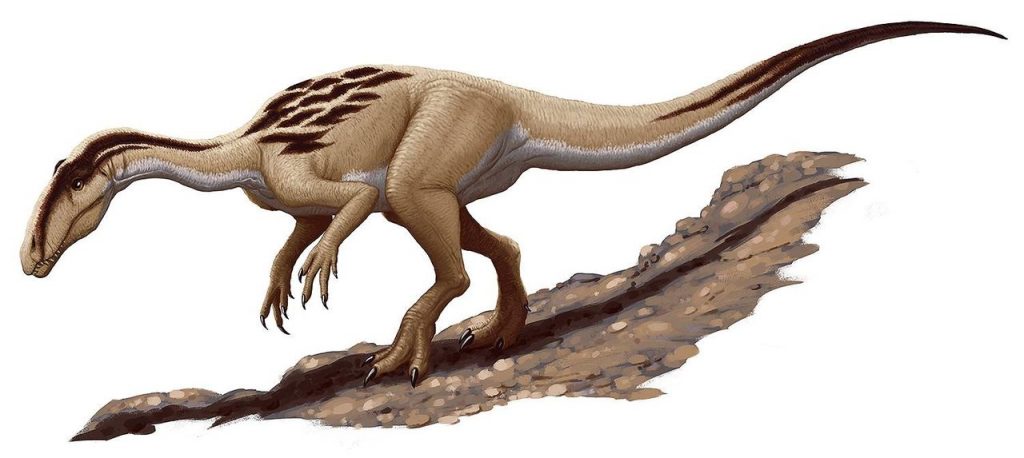Tablica nr 1
Przy Centrum Aktywności Wiejskiej
Velocipes guerichi (kocurypelta silvestris / the dinosaurs from Kocury)
In the forest in Kocury there is the place where the first fossils of a dinosaur were discovered in the territory of present Poland.
The bone of Velocipes guerichi is the only fossils of a dinosaur of this species found in the world. The name of this species consists of two parts: „velox” means fast and „pes” means a foot. And the epithet „guerichi” comes from the name of its discoverer. The bone of the dinosaur was discovered in Kocury at the end of the 19th century by Georg Gürich. Among many known and recognized fossils of reptiles this piece of the lower leg remains unrecognized. At an Institute in Hamburg in 1932, German paleontologist Friedrich von Huene examined this unidentified bone and determined the size of the animal, which he estimated to be 2 meters high and 4 meters long. He named it Velocipes guerichi [1].


Georg Julius Ernst Gürich, who discovered the bone of Velocipes, was born on the 25th of September,
1859 in Dobrodzień in the family of Eduard Gürich, who was a teacher. He studied Geology at the University of Wroclaw. He conducted geological studies in Silesia, in the Swietokrzyskie Mountains, and in the area surrounding Cracow. In 1885 he went to Niger and Sudan in Africa for research purposes. In 1888 he again went to South West Africa, and in 1890 he took up the exploration of deposits in Venezuela. In 1900 he became a professor and one year later an associate of Prussian Geological State Institute and worked on a new geological map of Silesia. In 1910 he was appointed a professor of Geology and Paleontology of Colonial Institute and a head of State Institute of Geology and Mineralogy in Hamburg. He died of a heart attack, during work, on the 16th of August, 1938. During the course of his
life, he published over 50 books and scientific papers [2].

Friedrich von Huene, brilliant German paleontologist, was born on the 22nd of March, 1875 and died on the 4th of April, 1969. He became famous by describing the largest number of dinosaur species in Europe [3].
In 1956 Friedrich von Huene in his huge work entitled “Paläontologie und Phylogenie der niederen Tetrapoden” (Paleontology and phylogeny of lower tetrapods) classified the Velocipes guerichi into Halticosauridae family, which covers tetrapods quite close to, among others, Coelophysis. In the middle of 1980s. the authenticity of Velocipes started to be questioned. In 2000 Oliver Rauhut and Axel Hungerbühler said that it was impossible to determine the origin of the bone. Therefore, they concluded
that Velocipes is an unidentifiable vertebrate [4].
Because the bone of Velocipes was considered to be destroyed during the World War II, during the bombing of Hamburg, probably all authors except of von Huene has not seen the holotype in person.
However, in 2012 it turned out that the bone has survived the war in a museum in Hamburg. Re-examination (carried out by the editors of the Dinozaury.com website) confirmed von Huene’s earlier concepts – the Velocipes holotype is an incomplete fibula probably belonging to a basal theropod which belonged to neotheropods to was closely related to them [5].

Since 2015, further excavations have been carried out in the Kocury village by Dr Tomasz Sulej’s research group. More species of prehistoric animals are being found. Fossils of a big aetosaurs belong to the new species Kocurypelta silvestris, fragments of the carapax of prehistoric turtles belong to Proterochersis porebensis, also known from the site in Poręba, located about 50 km east of Kocury. A tooth plate of a lungfish has also been discovered in the forest near Kocury.

- Źródło: http://dinozaury.com/?p=3935
- M. Syniawa „Biograficzny słownik przyrodników śląskich” tom 1, s. 126
https://www.sbc.org.pl/dlibra/publication/259059/edition/245046/content - Źródło: https://pl.wikipedia.org/wiki/Friedrich_von_Huene
- Źródło: http://dinozaury.com/?p=3935
- Źródło: http://www.encyklopedia.dinozaury.com/index.php?title=Velocipes